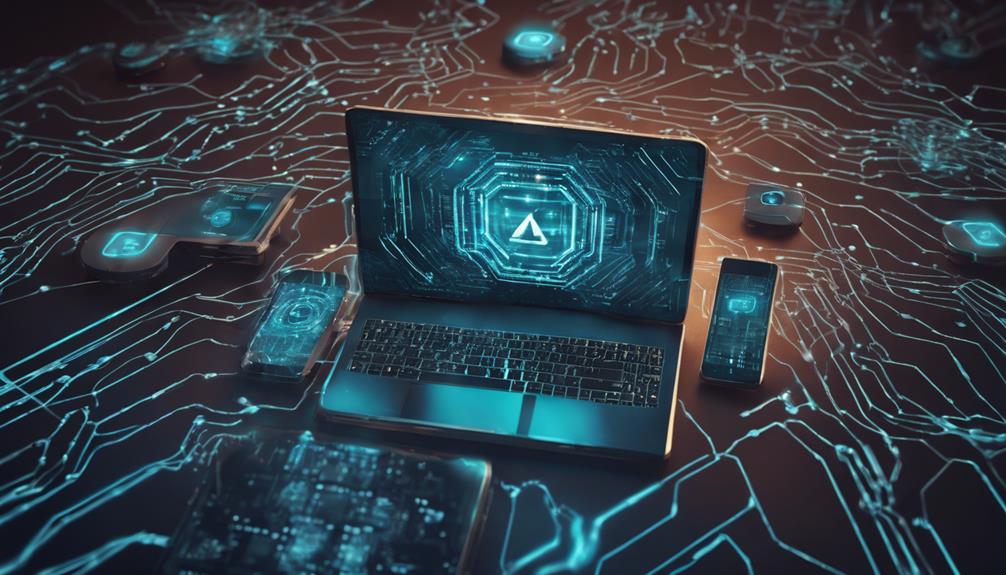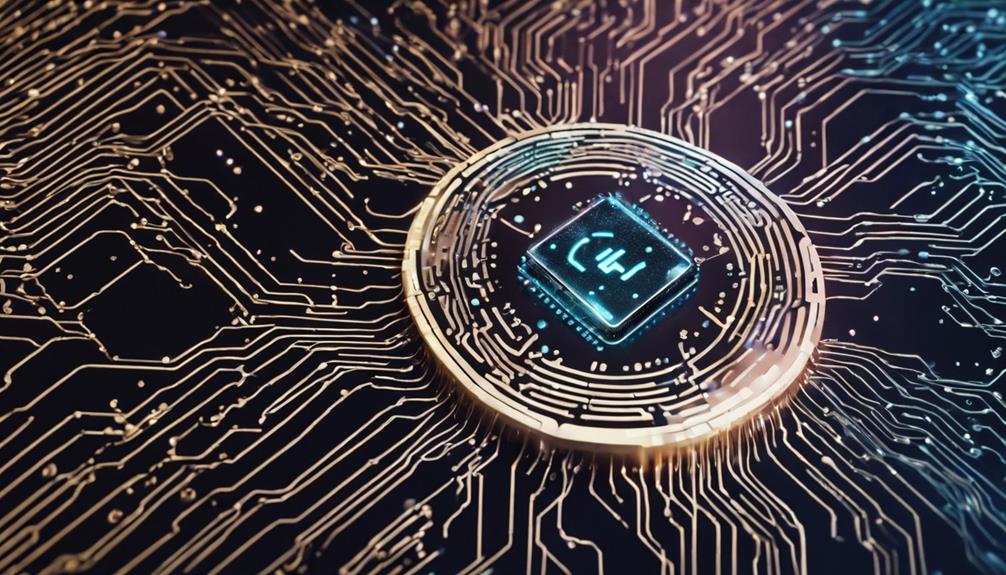Did you know that remote work has increased by 115% since 2005? As more organizations embrace remote work, the need for robust cybersecurity measures has become crucial to protect sensitive data and networks.1Remote work environments pose unique challenges when it comes to cybersecurity. Employees working remotely may be more susceptible to phishing attacks and social engineering tactics, making them potential targets for security breaches.2It is vital for businesses to implement and regularly update robust security policies to mitigate cybersecurity risks in dispersed remote work setups.2To maintain a secure remote work environment, it is essential to actively monitor and enforce security policies. By implementing secure authentication methods and effectively monitoring remote connections, organizations can safeguard against security incidents.2Additionally, implementing basic security controls such as Multi-Factor Authentication (MFA) and secure access protocols can help mitigate the heightened risk of data breaches in remote work environments.2The use of personal devices to connect to private networks or public Wi-Fi networks can expose companies to cybersecurity threats. To mitigate the risk of unauthorized access to corporate networks, it is crucial to implement secure Virtual Private Networks (VPNs) and authentication methods.
Unsecured networks in remote work environments expand the potential attack surface for cyber threats, highlighting the importance of robust access controls.2Regularly updating security patches and antivirus software is crucial to protect against potential vulnerabilities while utilizing online collaboration platforms. Keeping security systems updated helps patch vulnerabilities and protect systems from evolving cyber threats.2Enhancing an organization’s security level by investing in advanced security technologies and practices can effectively prevent cyber-attacks.
2Key Takeaways:
- Remote work has seen a significant increase in recent years, making cybersecurity a top priority for organizations.1
- Implementing robust security policies and regularly updating them is crucial in mitigating cybersecurity risks in remote work environments.2
- Using secure authentication methods, monitoring remote connections, and implementing basic security controls like MFA can help protect against data breaches.2
- Utilizing secure VPNs and authentication methods can mitigate the risk of unauthorized access to corporate networks.3
- Regularly updating security patches and antivirus software is crucial to protect against potential vulnerabilities.2
In the age of remote work, organizations must prioritize cybersecurity to protect their digital assets and maintain operational integrity. By implementing effective security measures and staying vigilant, businesses can navigate the remote work landscape with confidence.
Stay tuned for the next section, where we will explore the specific cybersecurity threats in remote work environments and how to address them effectively.
Continue to Section 2: Cybersecurity Threats in Remote Work Environments
Cybersecurity Threats in Remote Work Environments
Remote work environments introduce increased vulnerability to cyber threats and security breaches. With the rise in remote work, organizations must be proactive in addressing cybersecurity risks to protect sensitive data and ensure the integrity of their networks. The dispersed nature of remote work setups creates additional challenges, making it imperative to implement robust security measures.
One of the essential cybersecurity best practices in remote work is implementing robust cybersecurity measures to prevent cyber attacks effectively and safeguard sensitive information2. Remote work environments increase employees’ vulnerability to cyber threats, emphasizing the need to address technology vulnerabilities like secure remote access protocols and VPNs2. Implementing tools to prevent downloading sensitive data and monitoring remote employees’ activities are crucial steps to mitigate potential cybersecurity threats2.
Securing access to corporate systems is crucial in remote work setups. Multi-factor authentication (MFA) is highly recommended to reduce the risk of unauthorized access2. Additionally, unsecured networks in remote work environments can expand the potential attack surface for cyber threats, highlighting the importance of robust access controls and vigilant network monitoring2.
To ensure a secure remote work environment, it is essential to monitor remote access, enforce strict security protocols, and educate employees on the risks associated with remote access2. By implementing these measures, organizations can safeguard their networks from potential intrusions and protect sensitive data effectively.
Technology Vulnerabilities in Remote Work
Remote work environments have become increasingly prevalent, leading to a rise in employees’ vulnerability to cyber threats. The complex nature of securing IT systems is further compounded by the increased use of endpoint devices and networking connections2. These technologies provide more entry points for potential security breaches, highlighting the need for robust security measures.
One of the main challenges in remote work is the limited oversight of data usage, which heightens the risk of data breaches, leaks, and unauthorized access to sensitive information2. As employees access corporate networks remotely, ensuring secure remote access becomes paramount. Implementing secure authentication methods, such as multi-factor authentication (MFA), and monitoring remote connections effectively are crucial security measures2.
Another concern is the vulnerability of technologies used in remote work setups. Without proper security measures, these technologies are at risk of exploitation by cyber threats. To protect against potential vulnerabilities, organizations must stay proactive in monitoring and mitigating technology vulnerabilities2.
Implementing tools to prevent downloading sensitive data and monitoring remote employees’ activities are essential for safeguarding against security incidents2. By investing in robust security solutions and emphasizing the importance of secure remote access, organizations can protect their data and systems in the remote work landscape.
| Best Practices for Technology Vulnerabilities in Remote Work | |
|---|---|
| Security Measure | Description |
| Secure Authentication Methods | Implement multi-factor authentication (MFA) to enhance identity verification and prevent unauthorized access. |
| Vulnerability Monitoring and Mitigation | Continuously monitor and mitigate technology vulnerabilities by keeping systems up to date and patching security flaws. |
| Employee Activity Monitoring | Implement tools to monitor and analyze remote employees’ activities, ensuring compliance with security protocols and preventing data breaches. |
| Data Loss Prevention | Enable measures to prevent sensitive data from being downloaded or accessed without proper authorization. |
By implementing these best practices, organizations can strengthen their security posture and protect against technology vulnerabilities in remote work environments.
Implementing secure authentication methods, monitoring remote connections, and staying proactive in mitigating technology vulnerabilities are best practices for remote work security.
Data Breach Risks and Mitigation Strategies
In the age of remote work, organizations face heightened risks of data breaches, necessitating robust cybersecurity measures to protect sensitive information. With remote work becoming the standard for millions of people worldwide4, it is crucial to implement effective security protocols to mitigate potential threats. Adopting a Zero Trust methodology is essential, as traditional castle-and-moat cybersecurity approaches are no longer sufficient4.
One significant factor contributing to cybersecurity breaches is human error4. To combat this, comprehensive training programs should be implemented to educate remote workers on recognizing and responding to potential threats4. Endpoint security plays a crucial role in remote work environments, and organizations should establish multi-layered security plans that include antivirus software, regular patch updates, virtual private networks (VPNs), and encryption algorithms4.
As the landscape of remote work continues to evolve, organizations must remain vigilant and adaptable in their cybersecurity tactics4. This includes fostering a security-conscious culture, promoting innovation, and developing strong defense mechanisms4. By prioritizing data breach mitigation strategies and staying proactive, organizations can protect their valuable data and maintain operational integrity in a remote work environment.

Data Breach Risks and Mitigation Strategies
| Data Breach Risks | Mitigation Strategies |
|---|---|
| Human error, including phishing attacks and security breaches4 | Comprehensive training programs on data security best practices4 |
| Inadequate endpoint security in remote work environments4 | Implementation of multi-layered security plans, including antivirus software, regular patch updates, VPNs, and encryption algorithms4 |
| Emerging dangers and evolving cybersecurity threats4 | Innovation, a security-conscious culture, and strong defense mechanisms4 |
Remote Work Security Access Risks
As remote work continues to gain prominence, organizations must be aware of the access risks associated with employees working from outside the traditional office environment. Unauthorized entry points and insecure connections can pose significant threats to the security of corporate networks and sensitive data.
When employees use personal devices or rely on public Wi-Fi networks, the risk of cyberattacks and data breaches increases. These unsecured networks create opportunities for malicious actors to intercept sensitive information, compromising the company’s overall security.
To mitigate these risks, it is crucial to implement secure remote access measures. One effective solution is the use of Virtual Private Networks (VPNs). VPNs create encrypted connections between remote workers and corporate networks, ensuring that data remains confidential and protected from unauthorized access5.
Another critical aspect of remote work security is the implementation of robust authentication methods. Multi-factor authentication (MFA) adds an extra layer of protection by requiring users to provide multiple forms of identification to gain access to systems or data. By implementing MFA, organizations can mitigate the risk of data breaches in remote work setups2.
In addition to technical safeguards, educating employees about the risks associated with remote access is essential for proactive protection against cyber threats. Regular training on data security best practices empowers remote employees to recognize and respond effectively to security risks. By ensuring that employees are knowledgeable about potential threats, organizations can significantly enhance their security posture in remote work scenarios2.
However, securing remote work environments goes beyond technical measures and training. It requires establishing strict security protocols and enforcing compliance with these measures. By enforcing secure remote access policies and ensuring employees adhere to these protocols, organizations can safeguard their networks and protect data25.
Key Remote Work Security Access Risks:
| Risks | Impact | Mitigation Strategies |
|---|---|---|
| Unauthorized entry points | Potential security breaches and data leaks | Implement secure access protocols like VPNs and enforce strict security policies |
| Insecure connections | Vulnerable to interception and unauthorized access | Use VPNs to encrypt connections and ensure data confidentiality |
| Employee use of personal devices or public Wi-Fi networks | Increased exposure to cyber threats | Provide secure devices and educate employees about the risks of using unsecured networks |
Protecting data in remote work environments requires organizations to implement secure remote access measures, enforce strict security protocols, and educate employees on data security best practices. By addressing these access risks head-on, businesses can minimize the potential for cybersecurity incidents and maintain the integrity of their data25.
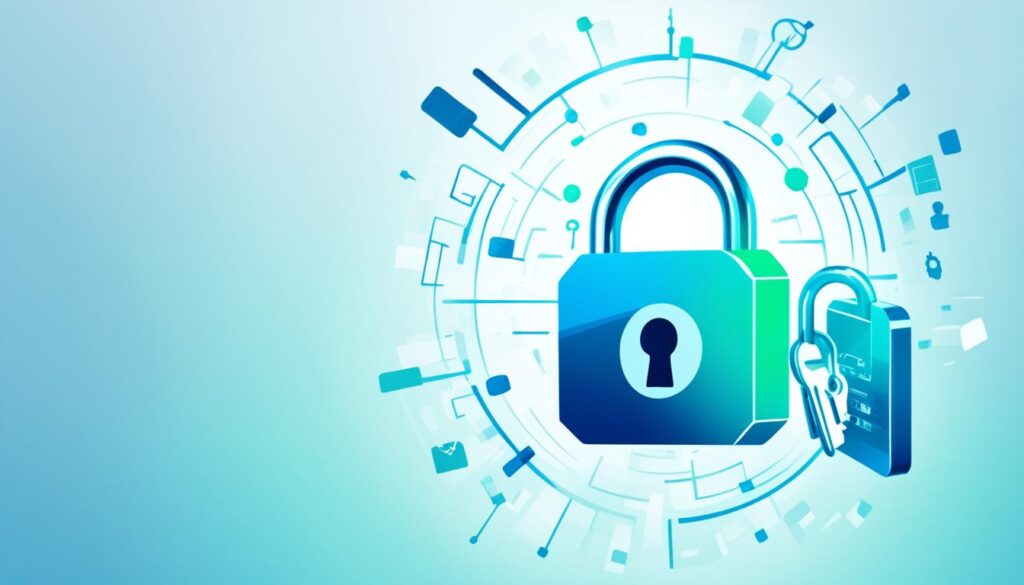
Network Security Concerns in Remote Work
In today’s remote work landscape, network security concerns have taken center stage, as organizations strive to protect their sensitive data and systems from cyber threats. The transition to remote work has significantly expanded the attack surface for potential cybersecurity breaches, emphasizing the need for robust security measures and proactive risk mitigation strategies.
Remote work setups often rely on unsecured and shared networks, which pose a significant risk to the confidentiality and integrity of critical information. The dispersed nature of remote work increases the vulnerability of organizations, making them a prime target for cybercriminals seeking to exploit security weaknesses. It is imperative for businesses to adopt comprehensive remote work security measures that address these network security concerns effectively.
The Vulnerability of Unsecured Networks
2 Unsecured networks in remote work environments create an expanded attack surface for cyber threats. Without proper encryption and access controls, sensitive data can be intercepted and compromised, leading to devastating consequences for organizations. The risks associated with unsecured networks highlight the importance of implementing robust access controls and network security measures.
Organizations must prioritize the adoption of secure protocols and encrypted connections, such as Virtual Private Networks (VPNs), to safeguard data transmission. VPNs establish secure tunnels, encrypting data and ensuring confidentiality while employees access resources remotely. This layer of protection mitigates potential risks arising from unauthorized access attempts and protects against eavesdropping and data interception on shared networks.
Monitoring Suspicious Activities
4 Monitoring suspicious activities on unsecured networks is crucial for effective network security in remote work environments. The decentralized nature of remote work setups presents challenges, as it becomes more challenging to detect and respond to potential threats. Organizations must invest in robust network monitoring tools and practices to identify and investigate any anomalies and suspicious behavior promptly.
Implementing Intrusion Detection Systems (IDS) and Intrusion Prevention Systems (IPS) enables real-time monitoring of network traffic, helping detect and mitigate potential threats. By continuously monitoring network activities, organizations can proactively detect and respond to security incidents, preventing potential breaches and minimizing the impact on critical systems and data.
Addressing Vulnerabilities in Shared Networks
Shared networks, such as public Wi-Fi connections, pose significant risks to remote work security. A comprehensive approach to network security and access controls is essential for mitigating potential threats associated with shared networks.
4 Organizations are advised to adopt a Zero Trust approach. This transformative methodology shifts the focus from traditional network perimeters to rigorous access restrictions and continuous authentication. Implementing a Zero Trust model involves verifying every user and device, regardless of their location or network connection. By assuming that any potential connection is untrusted, organizations can enhance network security and prevent unauthorized access attempts.
Regular security audits and compliance checks are also critical in addressing vulnerabilities in shared networks. These measures enable organizations to identify any security gaps and implement necessary updates and improvements to strengthen network security.
Cybersecurity Best Practices
4 To ensure a robust network security posture in remote work environments, organizations should adhere to cybersecurity best practices:
- Establish strong and unique passwords for all accounts and devices used for remote work.
- Regularly update software and firmware to patch vulnerabilities and protect against emerging cyber threats.
- 2 Enable multi-factor authentication (MFA) for all remote access to corporate systems. MFA adds an extra layer of protection by requiring additional verification beyond a password.
- 2 Utilize secure access protocols, such as VPNs or secure channels, to connect remote team members to company resources.
- Provide ongoing training and education on data security best practices to remote workers, empowering them to recognize and respond effectively to potential security risks. Regular reinforcement of security protocols is crucial to maintain a vigilant and security-conscious workforce.
By implementing these best practices and adopting proactive network security measures, organizations can protect their sensitive data, maintain the integrity of their systems, and face the challenges posed by network security concerns in remote work environments with confidence.
Collaboration Platform Risks
Online collaboration platforms have become indispensable tools for remote work, facilitating communication and enabling teams to collaborate efficiently. However, these platforms also introduce inherent risks that can compromise sensitive information and facilitate cybercriminal activities. To ensure the security of online collaboration platforms, organizations must implement robust security measures, stay informed about the latest security protocols and best practices, and actively monitor platform activity.
Implementing tools to prevent downloading sensitive data and monitoring remote employees’ activities are crucial steps in mitigating security challenges2. The dispersed nature of remote work setups can create additional cybersecurity risks, leading to a higher likelihood of a security breach2. To protect corporate information, it is essential to regularly update security patches to address vulnerabilities and keep collaboration platforms secure2. Collaboration with cybersecurity teams is also crucial, as it enables organizations to stay informed about emerging threats and implement effective security measures2.
One important aspect of securing online collaboration platforms is to enforce strict access controls and user authentication methods. Requiring multiple authentication factors through Multi-Factor Authentication (MFA) helps ensure secure access to corporate systems and prevents unauthorized entry2. Implementing secure VPNs and authentication methods is also crucial to mitigate the risk of unauthorized access to corporate networks2.
Regularly educating remote workers on data security best practices is another vital component of maintaining a secure collaboration environment. By empowering employees with knowledge and awareness, organizations can enhance their ability to recognize and respond effectively to potential security risks2. Educating employees on device security measures like password protection, limited access, and regular backups also ensures the security of their personal devices used for remote work2.
Securing sensitive data shared through online collaboration platforms requires the use of secure channels, encryption, and multi-factor authentication. These measures help protect information from unauthorized access and ensure data confidentiality2. Educating users on safe practices, such as avoiding sharing sensitive information in public channels and verifying the identity of recipients before sharing confidential documents, is also essential for maintaining the security and integrity of shared data2.
By actively monitoring and enforcing security policies, organizations can take proactive steps to prevent cyber threats and maintain a secure remote work environment. Monitoring platform activity helps detect and respond to any suspicious or unauthorized behavior, mitigating the risk of data breaches or unauthorized access2. Collaboration platform risks include compromising sensitive information and facilitating cybercriminal activities. Therefore, it is crucial for organizations to enhance the level of security by investing in advanced security technologies and practices2.
To summarize, securing online collaboration platforms is vital for maintaining data confidentiality, preventing unauthorized access, and protecting sensitive information. By implementing robust security measures, regularly updating security patches, educating users on best practices, and collaborating with cybersecurity teams, organizations can mitigate collaboration platform risks and ensure a secure remote work environment.
Cybersecurity Best Practices for Remote Work
In today’s era of remote work, cybersecurity best practices are essential to protect sensitive data and enhance the overall security posture of organizations. By implementing key security controls and investing in advanced technologies, businesses can mitigate cybersecurity risks and ensure a secure remote work environment.
Increased Vulnerability of Remote Employees
Remote work introduces unique challenges and vulnerabilities for employees, making them more susceptible to phishing attacks and social engineering tactics2. Heightened awareness and education regarding these threats are crucial for maintaining a strong cybersecurity posture in remote work settings.
Implement Multi-Factor Authentication (MFA)
One effective measure to enhance remote work security is the implementation of multi-factor authentication (MFA)2. By requiring multiple authentication factors, such as passwords and verification codes, MFA adds an extra layer of protection against unauthorized access to corporate systems.
Ensure Secure Access Protocols
All remote team members should utilize secure access methods, such as Virtual Private Networks (VPNs) or secure channels, to connect to company resources2. By encrypting data transmissions and establishing secure connections, organizations can significantly reduce the risk of data breaches and unauthorized access.
Regularly Update Security Systems
Keeping security systems up to date is a fundamental cybersecurity best practice2. Regular updates and patch management help address known vulnerabilities and strengthen the overall security posture, reducing the risk of successful cyber attacks.
Address Collaboration Platform Risks
Utilizing online collaboration platforms introduces inherent risks to the confidentiality and integrity of sensitive information2. Businesses should carefully assess and select platforms that meet robust security standards. Implementing access controls, encryption, and monitoring systems can further enhance the security of these platforms.
Enhance Security Measures
Continuously striving to enhance an organization’s security level is crucial2. By staying updated with the latest security technologies and industry best practices, businesses can proactively mitigate emerging cyber threats and maintain a strong cybersecurity posture.
Monitoring and Detecting Insider Threats
Implementing user behavior analytics tools and monitoring employee activities are vital for detecting insider threats in a remote work environment2. Prompt reporting of suspicious activities enables organizations to investigate and mitigate potential risks promptly.
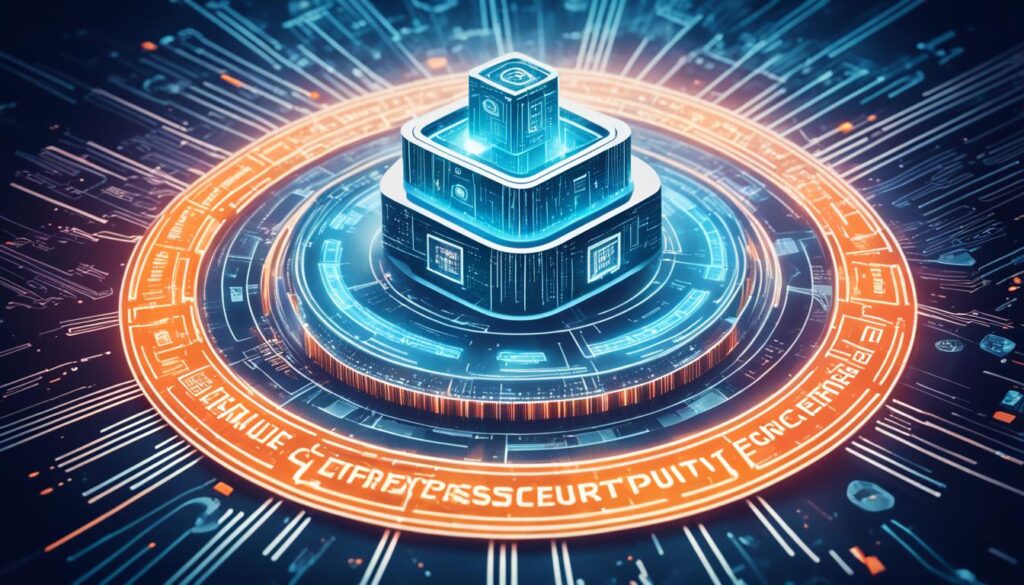
The Impact of Remote Work on Cybersecurity
The rise of remote work has significantly reshaped the modern workplace, with global events like the COVID-19 pandemic accelerating its adoption6. As more employees access company data and systems from remote locations, organizations face an increased risk of cyber attacks6. To ensure the security of their remote workforce, businesses need to take proactive steps and implement robust cybersecurity measures.
Password policies play a crucial role in safeguarding remote work environments. By enforcing strong and unique passwords, organizations can mitigate the risk of unauthorized access to sensitive data6. Additionally, implementing two-factor authentication adds an extra layer of security, effectively protecting against unauthorized account access6.
Regular software updates are essential for remote work cybersecurity. Keeping operating systems, applications, and security software up to date ensures that vulnerabilities are patched, reducing the risk of cyber attacks6. These updates often contain crucial security fixes that address newly discovered vulnerabilities, strengthening the overall security posture of remote work environments.
Virtual Private Network (VPN) technology is a cornerstone of remote work cybersecurity. VPNs create secure encrypted connections, allowing remote employees to transmit data safely over public networks6. By masking IP addresses and encrypting data, VPNs provide an essential layer of security, particularly when accessing corporate networks and sensitive information remotely.

The adoption of remote work trends necessitates a shift in cybersecurity practices. Phishing schemes and ransomware attacks have become more prevalent in remote work environments, emphasizing the need for heightened vigilance and employee cybersecurity training6. Organizations must invest in comprehensive cybersecurity training programs that cover both technical and behavioral aspects to reduce vulnerabilities to cyberattacks7.
Remote workers have demonstrated a higher level of cybersecurity awareness and are more likely to take security-related precautions compared to their in-office counterparts7. Information security policy compliance plays a significant role in raising remote workers’ awareness of cybersecurity best practices7. The positive association between remote working and cybersecurity awareness highlights the importance of fostering trust, personal responsibility, and a strong cybersecurity culture within remote work arrangements7.
As organizations transition towards hybrid workforces, it is essential to reevaluate cybersecurity strategies7. Adapting policies and practices can help address emerging challenges and opportunities in remote and office environments7. Future research should explore different remote work arrangements, organizational culture, leadership, and technology to provide insights for developing effective cybersecurity strategies in both remote and office settings7.
In conclusion, remote work has revolutionized the traditional workplace, but it also presents unique cybersecurity challenges. By implementing password policies, two-factor authentication, regular software updates, and VPN technology, organizations can enhance remote work cybersecurity. Collaboration with cybersecurity experts and ongoing training programs are vital in maintaining a strong security posture and protecting against cyber threats in remote work environments.
The Landscape of Remote Work
The remote work landscape has undergone a significant transformation with the rise of digital nomadism and decentralized workforces. Professionals now have the flexibility to work from various locations, allowing them to embrace a nomadic lifestyle while continuing their professional endeavors. However, this newfound freedom comes with its own set of challenges, especially when it comes to cybersecurity and protecting sensitive data. Striking a balance between productivity and security is crucial in navigating the evolving landscape of remote work.
Evolving communication technologies have enabled seamless connectivity for remote workers, facilitating efficient collaboration and information sharing. However, the decentralization of workforces and the use of personal devices introduce vulnerabilities that can be exploited by cyberthreats. Securing networks, devices, and the flow of information has become a critical concern for organizations operating in the remote work landscape.
One of the key considerations in remote work security is addressing the unique challenges posed by IoT devices in home offices. As remote workers connect their devices to corporate networks, the potential for cyberattacks increases. Ensuring that all IoT devices are properly secured and regularly updated with the latest security patches is essential in preventing unauthorized access and protecting sensitive information.
Securing Networks and Data:
Implementing robust security measures is paramount to safeguarding networks and data in remote work environments. Remote team members should utilize secure access methods, such as virtual private networks (VPNs) or secure channels, to connect to company resources. This helps protect sensitive data from security threats and mitigates the risk of breaches caused by unauthorized access.
“Implementing tools to prevent downloading sensitive data and monitoring remote employees’ activities are crucial steps in mitigating potential security threats.”2
Monitoring remote access and enforcing strict security protocols are essential aspects of maintaining a secure work environment. By closely monitoring network activity and user behavior, organizations can detect and respond promptly to potential intrusions or security incidents.
Regular data security training for remote workers is vital in empowering them to recognize and respond effectively to potential security risks. Educating employees about best practices for secure remote work, including identifying and reporting suspicious activities, helps strengthen the overall security posture.
“Data security training for remote workers is essential to empower them to recognize and respond to potential security risks effectively.”2
Implementing robust access controls is crucial for securing unsecured networks in remote work environments. By carefully managing user access privileges and implementing authentication methods, organizations can limit the potential attack surface for cyber threats, reducing the risk of security breaches.
Regularly updating security protocols and systems is vital for organizations to maintain a high level of cybersecurity. Keeping up with the latest security patches and antivirus software updates safeguards against potential vulnerabilities and cyber threats.
“Regularly updating security protocols and systems is vital for an organization to maintain a high level of cybersecurity.”2
Continuously investing in advanced security technologies and practices is crucial for preventing and safeguarding against cybersecurity risks. By staying informed about emerging threats and adopting cutting-edge security solutions, organizations can effectively protect their valuable assets.
“Continuously investing in advanced security technologies and practices can help prevent and safeguard a company’s valuable assets effectively.”2
The landscape of remote work offers exciting opportunities for professionals to embrace flexible work arrangements and explore new horizons. However, it is essential to address the unique cybersecurity challenges that arise in this decentralized work environment. By implementing robust security measures, educating employees, and staying proactive in mitigating risks, organizations can navigate the remote work landscape with confidence and ensure the protection of their networks, devices, and valuable information.
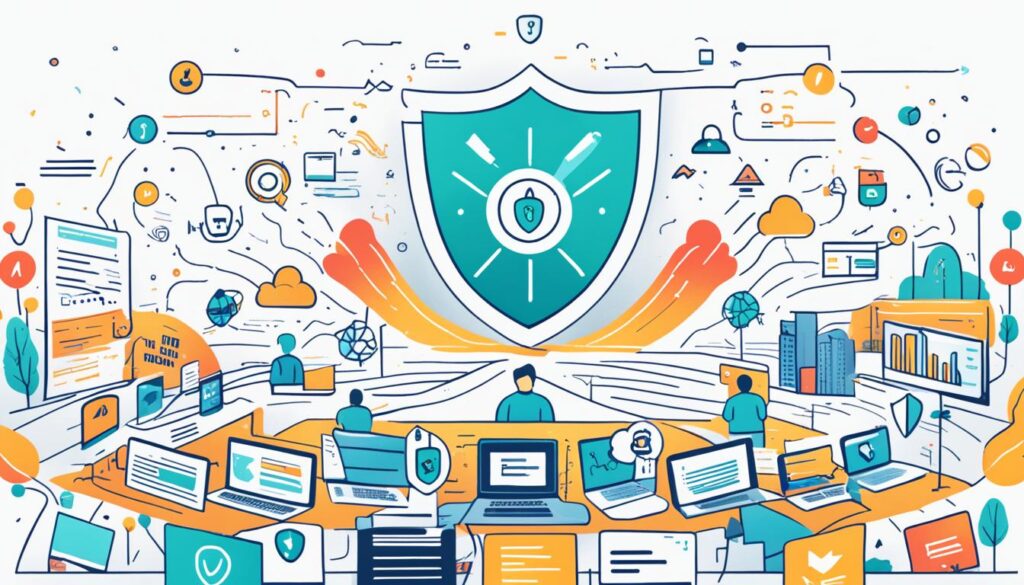
Key Cybersecurity Challenges in Remote Work
Remote work presents a range of cybersecurity challenges that organizations must address to maintain a secure and productive remote work environment. These challenges include endpoint security, secure communication channels, phishing attacks, home network security, and data loss prevention.
Endpoint security is a major concern in remote work setups, as employees often use personal devices to access company networks. This introduces the risk of unauthorized access and potential data breaches. To mitigate this risk, organizations should implement comprehensive endpoint protection solutions such as antivirus software and firewalls8.
Ensuring secure communication channels is crucial in remote work scenarios to protect sensitive information during virtual collaboration. Utilizing secure communication platforms that utilize end-to-end encryption helps safeguard data from unauthorized access8.
Phishing attacks pose a significant threat to remote workers, as deceptive messages can compromise sensitive information. Regular security training and awareness programs are essential to educate remote employees about recognizing and responding to phishing attempts89.
Home network security is often weaker compared to corporate networks, making it susceptible to unauthorized access. Encouraging employees to secure their home Wi-Fi networks with strong passwords and encryption is crucial to maintaining a secure remote work environment8.
To address these challenges and enhance remote cybersecurity, organizations should implement various strategies and best practices. These include implementing VPNs for secure connections, multi-factor authentication for additional security layers, regular security training to educate employees about cybersecurity best practices, and conducting regular security audits and network activity monitoring8.
“Implementing Virtual Private Networks (VPNs) provides secure, encrypted connections between remote workers and corporate networks, ensuring the confidentiality of sensitive data89.”
Moreover, organizations should collaborate with cybersecurity experts to gain insights and expertise in tackling remote work cybersecurity challenges effectively8.
By addressing these key cybersecurity challenges, organizations can establish a secure remote work environment that protects sensitive data, mitigates cyber threats, and enables remote employees to work with confidence and peace of mind.
Effective Cybersecurity Measures for Remote Work
As organizations embrace remote work, it is crucial to prioritize effective cybersecurity measures to protect sensitive data, networks, and systems. Implementing robust security practices ensures a safe and secure remote work environment, minimizing the risk of cyber threats and security breaches.
One key aspect of remote work cybersecurity is the implementation of VPN technology. VPNs (Virtual Private Networks) provide secure data transmission by encrypting traffic between remote workers and company systems. This safeguards sensitive information from interception and unauthorized access, helping organizations maintain data integrity and privacy3.
Another critical measure in remote work cybersecurity is the implementation of multi-factor authentication (MFA). MFA adds an extra layer of protection against unauthorized access by requiring remote employees to provide multiple forms of identification, such as passwords, biometrics, or security tokens. This enhances corporate system security and reduces the risk of unauthorized access to sensitive data23.
Endpoint security is also paramount in remote work environments. With the increased use of endpoint devices and networking connections, securing IT systems becomes more complex. Adequate endpoint security measures, such as implementing tools to prevent downloading sensitive data and monitoring remote employees’ activities, are crucial for mitigating potential security threats2.
Regular security training for remote workers is essential in developing a security-conscious workforce. Educating employees on data security best practices empowers them to recognize and respond effectively to potential security risks. By educating remote workers on device security measures, password protection, limited access to work devices, and secure storage practices, organizations can ensure the security of personal devices used for remote work2.
Collaboration with cybersecurity experts can further enhance remote work cybersecurity. These experts can assist in establishing secure access protocols for remote team members, monitoring remote connections, and continuously updating security measures. By staying proactive in mitigating potential threats and addressing vulnerabilities, organizations can bolster their remote work security posture and safeguard sensitive data from evolving cyber threats2.
Effective Cybersecurity Measures for Remote Work
| Measures | Description |
|---|---|
| Implement VPN technology | Utilize VPNs for secure data transmission and encryption of traffic between remote workers and company systems. |
| Apply multi-factor authentication (MFA) | Implement MFA to enhance identity verification and add an extra layer of protection against unauthorized access. |
| Ensure endpoint security | Implement tools and monitoring mechanisms to prevent downloading sensitive data and monitor remote employees’ activities. |
| Provide regular security training | Educate remote workers on data security best practices, device security measures, and password protection. |
| Collaborate with cybersecurity experts | Seek guidance from cybersecurity experts to establish secure access protocols, monitor remote connections, and continuously update security measures. |
By implementing a combination of these effective cybersecurity measures, organizations can strengthen their remote work security framework, ensuring the protection of sensitive data, networks, and systems. This proactive approach mitigates potential security threats, safeguards valuable assets, and instills confidence in remote work operations.
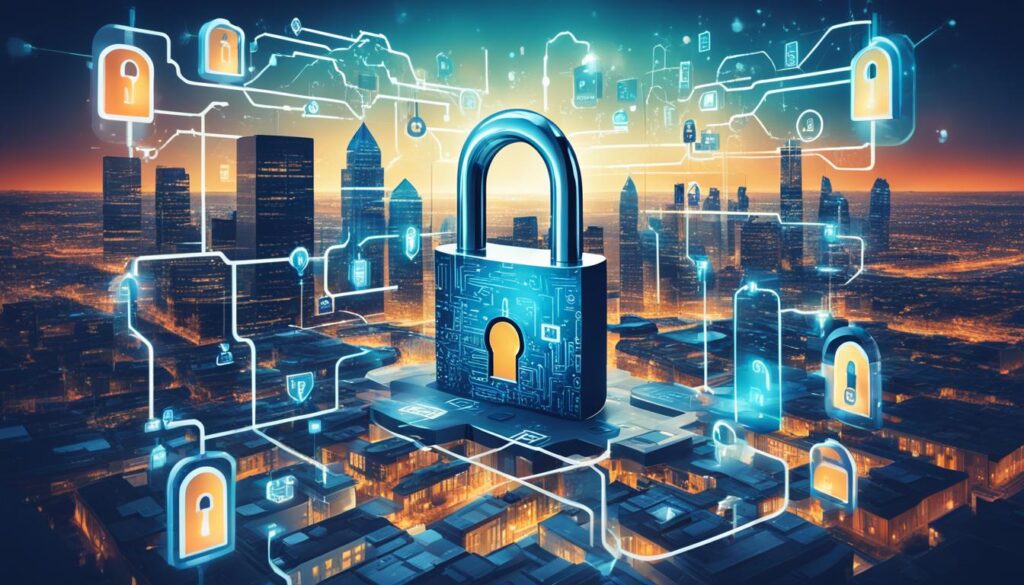
Conclusion
As remote work continues to gain momentum, organizations must prioritize cybersecurity measures to safeguard digital assets and maintain operational integrity. The decentralization of the workforce presents unique challenges that necessitate a holistic approach to remote work security measures. By implementing effective cybersecurity practices, such asstrong password policies and two-factor authentication3, regularly updating software10, and utilizing VPN technology3, companies can create a secure and productive remote work environment.
Remote work poses an increased risk of cyber attacks due to the usage of unsecured networks and devices3. However, by staying proactive and providing regular cybersecurity training for employees3, organizations can significantly reduce the risk of falling victim to cyber attacks. Furthermore, maintaining strong cybersecurity measures is essential for preserving the trust of customers and stakeholders3.
Remote work has amplified the risk of cyberattacks by 300% since the start of the COVID-19 pandemic10. The surge in cyber attacks, which has increased by 44% over the past five years10, highlights the critical need for robust remote work security measures. The number of attacks targeting the government sector has also seen a 95% increase worldwide in the second half of 202210.
In conclusion, as remote work becomes more prevalent, businesses must proactively address the emerging challenges and potential cybersecurity threats. By prioritizing remote work security measures and collaborating with cybersecurity experts3, organizations can thrive in the remote work landscape while effectively protecting their data and systems.
FAQ
What are some common cybersecurity threats in remote work environments?
How can organizations ensure secure remote access for their employees?
What measures can organizations take to protect data in remote work?
What are the access risks associated with remote work?
How can organizations address network security concerns in remote work?
What security measures are important for protecting online collaboration platforms in remote work?
What are some best practices for remote work cybersecurity?
How does remote work impact cybersecurity?
What are the key cybersecurity challenges in remote work?
What are some effective cybersecurity measures for remote work?
Source Links
- https://www.kwikom.com/blog/cybersecurity/2024/04/25/cybersecurity-threats-in-the-age-of-remote-work/
- https://www.wheelhouseit.com/cybersecurity-in-the-age-of-remote-work/
- https://www.collaboris.com/cybersecurity-remote-work/
- https://www.linkedin.com/pulse/cybersecurity-age-remote-work-dhairya-seth-sau1c
- https://www.mediumstech.com/cybersecurity-in-the-age-of-remote-work/
- https://medium.com/@gupta.brij/the-impact-of-remote-work-on-cybersecurity-challenges-and-solutions-1e7aa5db9927
- https://www.linkedin.com/pulse/in-office-work-real-threat-cybersecurity-dr-gleb-tsipursky-bh15c
- https://mediumstech.com/cybersecurity-in-the-age-of-remote-work/
- https://www.linkedin.com/pulse/cybersecurity-age-remote-work-best-practices-emerging-ron-klink-pjbse
- https://exito-e.com/cybersecuritysummit/blog/cybersecurity-in-the-age-of-remote-work/


